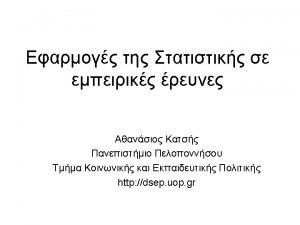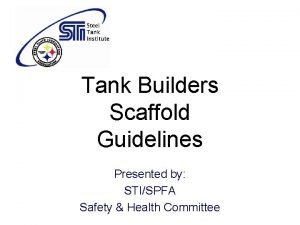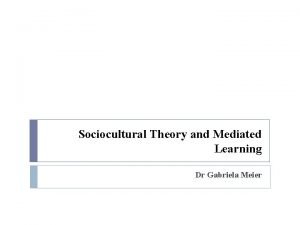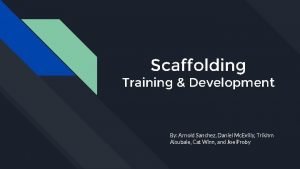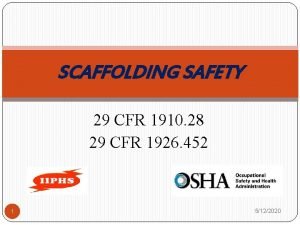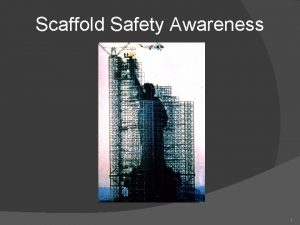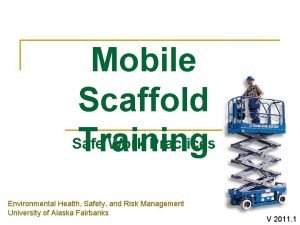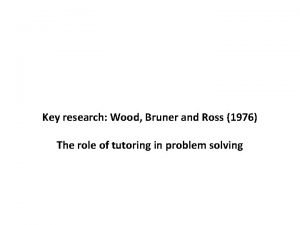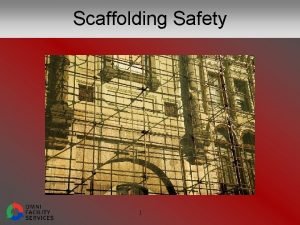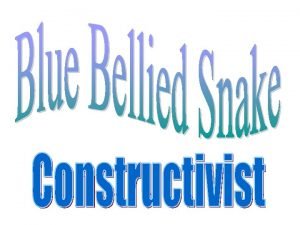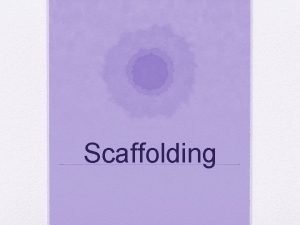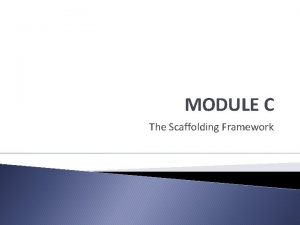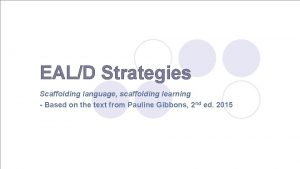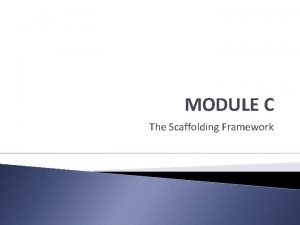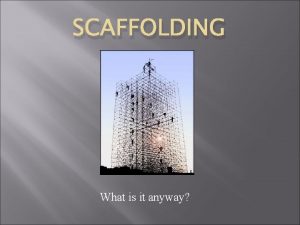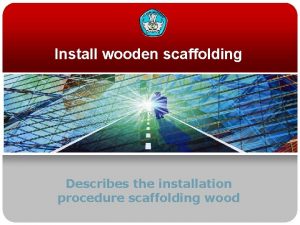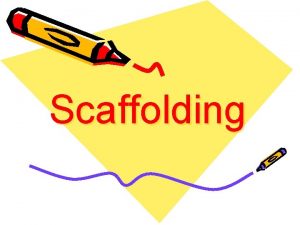Instructional Scaffolding In education scaffolding refers to a


















- Slides: 18

Instructional Scaffolding

In education, scaffolding refers to a variety of instructional techniques used to move students progressively toward stronger understanding and, ultimately, greater independence in the learning process. The term itself offers the relevant descriptive metaphor: teachers provide successive levels of temporary support that help students reach higher levels of comprehension and skill acquisition that they would not be able to achieve without assistance. Like physical scaffolding, the supportive strategies are incrementally removed when they are no longer needed, and the teacher gradually shifts more responsibility over the learning process to the student. Scaffolding Definition. (2013, November 7). Retrieved from http: //edglossary. org/scaffolding/

What does instructional scaffolding DO? ? • Helps ensure a student’s success • Extends competence into new territory • Can be taken away as the student becomes more responsible – Here, think about the building metaphor – scaffolding as you are putting up a building. When the building is built, you don’t need the scaffolding.

Names • Jerome Bruner – The Process of Education • Lev Vygotsky – Thought and Language

Scaffolding • Linking what we know about learning in more “natural” contexts to how we think about learning in schools (less natural contexts) • Trying to translate things that work in a one-on-one model to a school classroom situation

Social Construction of Knowledge • Knowledge is constructed rather than transmitted • Learning happens through social interaction

Zone of Proximal Development • Cognitive distance between what learners know and can do on their own, and what they are currently capable of doing with the assistance of a more knowledgeable person. • The novice reader or writer learns new skills in contexts where more skilled language users provide the support necessary to carry through unfamiliar tasks • The most appropriate tasks will be those that involve abilities that have not yet matured but are in the process of maturation , or in Vygotsky’s terms, abilities that are not so much “ripe” as “ripening. ”

Components of Scaffolding • Intentionality/student ownership of the goals • Appropriateness • Structure/supportive instruction • Collaboration/shared responsibility • Internalization

Scaffolded teaching learning A sequence for planning • A Getting Ready • B Show me how (modelling) • C Help me do it (guided practice) • D Let me do it myself (independent practice) • E What did I learn?

Scaffolding.

Scaffolding in Practice What do parents do to encourage their children to speak? • Expect them to speak • Provide models of how spoken language works • Demonstrate how to listen • Support their attempts with praise

What do teachers do? Macro Level Scaffolding • clear goals or outcomes • an understanding of linguistic demands of tasks • knowledge of the students , their abilities and understandings • careful sequencing of tasks to achieve the goal/outcome • gradual shift of responsibility from teacher to student

What do teachers do? Micro Level Scaffolding • student-teacher dialogue within small groups – where paraprofessionals mostly work • Students need to be scaffolded: – from home language to school language and – from spoken to written language

I DO • In this initial step, the teacher models the proper way to understand perform the steps in the new concept being taught. In this stage, students are told to put their pencils and pens down and give full attention to how the new concept is being modeled by the teacher.

WE DO • After you, as a teacher, home educator, or parent models the correct way to understand or perform the new concept being taught, you partner with the students or child and work through some examples together. This allows for a deeper level of learning to develop. Students are able to engage in the learning process beyond listening.

• This helps build confidence for the timid students or children with learning disabilities

You Do It • This can be independent or collaboratively with another student • This is where they demonstrate their initial level of understanding of the new concept being taught through independent practice.

 Scaffolding instructional design
Scaffolding instructional design Zpd and scaffolding examples
Zpd and scaffolding examples Scaffolding education definition
Scaffolding education definition Value added model education
Value added model education Emoticon terima kasih
Emoticon terima kasih Tank builders scaffold
Tank builders scaffold Scaffolding teaching method
Scaffolding teaching method Scaffolding theory bruner
Scaffolding theory bruner Patented scaffolding images
Patented scaffolding images Mc scaffolding
Mc scaffolding Bridle in scaffolding
Bridle in scaffolding Osha 1910 scaffolding
Osha 1910 scaffolding Scaffolding techniques for ells
Scaffolding techniques for ells Bad planking scaffolding
Bad planking scaffolding Act 520
Act 520 Mobile scaffold inspection requirements.
Mobile scaffold inspection requirements. What is vygotsky's theory of scaffolding learning
What is vygotsky's theory of scaffolding learning Wood bruner ross
Wood bruner ross Scaffolding adalah psikologi
Scaffolding adalah psikologi



